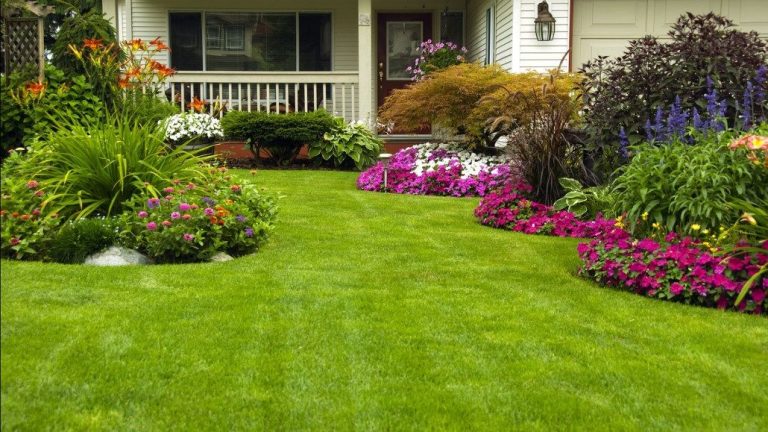In the United States, the average home has about a quarter of an acre (or 10,871 square feet) of lawn. That’s a lot of green space – and all that green takes some time to maintain and make sure that your deck has a green element too.
Most people spend the majority of their time mowing, fertilizing, weeding, and seeding in the summer. However, it’s not just July and August when you need to be tending to your turf.
To keep your lawn looking great in every season, there are certain steps you need to take in the spring, fall, and winter, too.
Here’s what you need to know.
Lawn Care Tips for Spring
If you’re feeling a stronger drive to care for your lawn in the spring, it’s for good reason – this is the time of year when your lawn needs the most TLC! Wait to apply fertilizer until your lawn has actually started to grow. The roots will store enough carbohydrates from the previous fall to encourage early spring growth.
When you do fertilize, choose a light, slow-release, or organic lawn fertilizer to make sure you don’t burn the lawn that’s still recovering from harsh winter weather. Give your lawn about one inch of water per week. You don’t have to water quite as heavily as you might in the summer, since the soil is still likely holding moisture from the winter snowfall.
In some cases, it may make sense to overseed at this time of the year, too. Wait to overseed if you have cool-season turfgrass but go ahead and do it now if you have warm-season grass. You can also lay mole traps if moles have been a problem for your lawn and apply a pre-emergent herbicide if you want to get rid of weeds before they appear.
That’s all you need to do! Hold off on mowing until the grass has really started growing – it’s okay to wait until it’s a bit taller than normal to give it a haircut.
Lawn Care Tips for Summer
Summer is the time that you should be spending enjoying your lawn – but that’s not to say that there aren’t steps you should be taking to keep your lawn healthy, either.
Mow your lawn regularly, ideally about once per week. If you can, keep it at a taller length, since lawns that are three inches or slightly higher have a tendency to develop deeper root systems (you can get away with two inches for warm-season grass). When you mow, leave the clippings on the lawn to serve as mulch and fertilizer for the live grass beneath.
Summer is also when you will want to kick your sprinkler system back on. Depending on your soil type, you’ll be watering at a depth of anywhere from 0.8 to 3.2 inches per foot (clay soil will be watered more deeply while sandy soil not so much).
Water in the early morning before the sun gets too high and be sure to take rainwater into effect when determining how much moisture your grass needs.
Summer is also the time when you’ll start to notice weeds. If you didn’t use a pre-emergent herbicide in the spring, you can get rid of weeds with a post-emergent herbicide or by simply pulling them out by hand.
Lawn Care Tips for Fall
Once the days start to get shorter, many people assume that their lawn care chores have ended. That’s not the case. There are still steps you can take to keep your lawn looking gorgeous through the end of the year – and into next.
Dethatching is an important step you can take. Removing thatch will help prevent your lawn from being suffocated by small branches, fallen leaves, and dead grass. You can use a power rake or vertical mower to do this.
Aeration is helpful, too. This act will break down compacted soil by plugging little holes into your lawn, allowing nutrients and water to reach the grass roots more effectively.
Finally, you may want to consider overseeding and fertilizing in the fall. Autumn is a great time to overseed cool-season turfgrasses. As for fertilizer, know that lawns are less likely to turn brown when you use a slow-release fertilizer in the early fall months. Just make sure you fertilize only after it has rained to prevent burning your grass.
Keep mowing until the frost – allowing your lawn to get too tall will encourage fungal diseases, like snow mold. That said, you should avoid cutting it too short since this can make it more difficult for your lawn to survive the winter.
Lawn Care Tips for Winter
Unless you live in a warm environment or have enough hot water that doesn’t experience a harsh winter, there’s not much you’ll be able to do to stop your lawn from turning brown over the winter. That doesn’t mean that the winter is a time to ignore your lawn completely! Follow these winter lawn care tips.
First, plan ahead. Remove all dead leaves before the first snowfall so that wet spots and moldy patches don’t form. Use an herbicide to prevent annual cool-season weeds from taking over dormant grass. Every now and then, you may find that it’s beneficial to drag a rake over your lawn. This will help break down hard clumps of soil so that water can better penetrate to dormant grass roots.
Also, practice good “lawn hygiene” during the winter. Make sure nobody parks cars on the lawn during the dormant period and do your best to limit foot traffic there, too.
In fact, the most important thing you can do for your lawn during the winter is to make sure it stays clean and tidy at all times. This isn’t just to prevent tripping hazards – it’s also to protect your grass. Don’t leave children’s toys, lawn furniture, debris, or even plant leaves on the grass. This can smother old and new growth alike and invite harmful pests and diseases.
A Healthy Lawn Requires Year-Round Attention
Regardless of the season, your lawn is a reflection of you and your home. Whether it’s spring, summer, winter, or fall, these tips will help you keep your grass looking great all year round.
Author’s Bio:

Kym Preslar is a bit of a gardening and home improvement fanatic. She’s been working on her garden for over 5 years and loves writing about everything landscape-related. Whether it’s keeping care of sod or the greenhouse, she’s been there and done it all. Currently, she’s enjoying her time working at SodLawn as their Content Manager.

